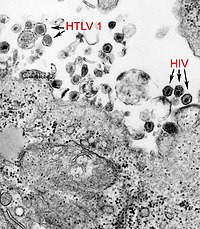
Photo from wikipedia
Human T-lymphotropic virus type I (HTLV-I) is a retrovirus associated with adult T-cell lymphoma (ATL) and HTLV-I-associated myelopathy/tropical spastic paraparesis (HAM/TSP). In addition to HAM/TSP and ATL, HTLV-I-associated encephalopathy and… Click to show full abstract
Human T-lymphotropic virus type I (HTLV-I) is a retrovirus associated with adult T-cell lymphoma (ATL) and HTLV-I-associated myelopathy/tropical spastic paraparesis (HAM/TSP). In addition to HAM/TSP and ATL, HTLV-I-associated encephalopathy and cerebellar involvement have been reported. We report a case of an 87-year-old Japanese woman presenting with progressive dysarthria and gait disturbance. Neurological examination showed word-finding difficulty, scanning speech, saccadic eye movements, ocular dysmetria, gaze-evoked nystagmus and bilateral dysmetria. There was no motor weakness or spasticity. HTLV-I antibody was detected in both her serum and cerebrospinal fluid. Cerebrospinal fluid neopterin (57 pg/mL) and IgG index (3.27) were significantly elevated. MRI showed cerebellar swelling. She was finally diagnosed with HTLV-I associated cerebellitis. Two courses of high-dose intravenous methylpredonine therapy attenuated cerebellar ataxia and cerebellar swelling. It suggests that cerebellitis can result from HTLV-I infection, regardless of the existence of ATL or HAM/TSP.
Journal Title: BMJ Case Reports
Year Published: 2021
Link to full text (if available)
Share on Social Media: Sign Up to like & get
recommendations!